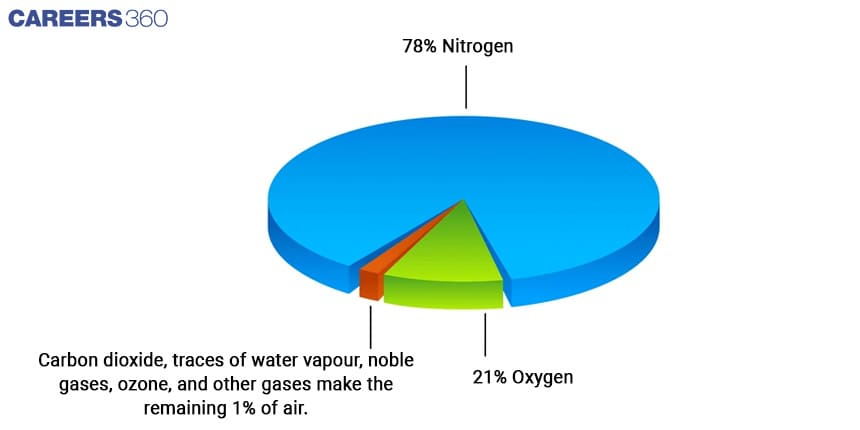A Class 6 Guide To The Wonders Of Air Around
Take a moment to think about something invisible that's all around us, something we can't see or touch yet can't live without. That magical thing is air! Yes, the same air we don't notice until it rustles the leaves or makes our kite soar high in the sky.
This Story also Contains
- The Presence of Air
- Composition of Air
- Importance of Air
- Other Properties of Air

We might not see it, but we sure can feel the gentle air in so many ways. From the way it moves the leaves on trees to the excitement of flying a kite, air is a silent companion in our everyday adventures.
In this article, let's unravel the mysteries of the air around us. We'll explore its invisible presence, discover what it's made of, and even learn how it supports life in ways we might not have imagined. So, buckle up for a journey into the unseen world of air!
The Presence of Air
Imagine a world where nothing moves, where leaves don't move, clothes don't sway, and kites don't fly. Doesn't that sound a little boring? We can thank air, our invisible friend, for keeping the world around us alive with a little bit of excitement.
Remember that when you see the leaves on trees rustling or clothes hanging on a line swaying, that's air saying hello. When the fan starts spinning, the same air causes the pages of your open book to flutter. And, oh, the joy of flying a kite - it's the gentle push of the air that allows your kite to perform its aerial movement.
Do you remember when you used to winnow sand and sawdust? That's another way air demonstrates its might. It's like a hero from behind the scenes, making mundane moments more exciting. Even during storms, when the wind howls and the trees sway, it's the air reminding us that it's still there, strong and unstoppable.
So, whether you're spinning a "firki" or simply enjoying the breeze on your face, remember that it's the air - our unseen companion - that makes those moments memorable.
Composition of Air
The air we breathe is a dynamic mixture of gases that creates a life-sustaining blend that envelops our planet. The atmosphere, an invisible medium, is primarily composed of nitrogen, oxygen, carbon dioxide, and water vapour, among other trace gases. Each component contributes to the characteristics and functions of the air that surrounds us.

Nitrogen (N2): Nitrogen is the most abundant gas in our atmosphere, accounting for approximately 78% of the total volume. Nitrogen, despite its abundance, is a relatively inert gas, which means it does not readily react with other substances. This stability is critical because it ensures that the atmospheric balance remains intact, fostering a life-friendly environment.
Oxygen (O2): Oxygen, which makes up about 21% of the atmosphere, is essential to the survival of many organisms, including humans. This gas is essential for cellular respiration, which is the process by which living organisms extract energy from their surroundings. Life as we know it would cease to exist if there was insufficient oxygen.
Carbon Dioxide (CO2): Although present in trace amounts—about 0.04%—carbon dioxide plays a critical role in regulating Earth's temperature via the greenhouse effect. Plants rely on carbon dioxide as well during photosynthesis, the process by which they convert sunlight into energy and release oxygen as a byproduct. Maintaining a stable climate requires a delicate balance of carbon dioxide in the atmosphere.
Water Vapour (H2O): Another essential component of air is water vapour, which exists in varying concentrations depending on location and climate. It plays an important role in the formation of clouds and precipitation. The water cycle, which is powered by evaporation from oceans, lakes, and rivers, ensures a constant exchange of moisture between the atmosphere and the Earth's surface.
The composition of air is inextricably linked to life's sustenance and ecosystem health. The unique combination of gases creates an environment in which organisms can thrive, ensuring the survival of Earth's intricate web of life. The exchange of gases in the atmosphere facilitates processes like respiration, photosynthesis, and combustion, all of which are critical to the survival of various life forms.
Importance of Air
Our air is more than just empty space; it is a vital life-support system.
First and foremost, there is respiration. When we breathe in, we are inhaling oxygen, a unique component of the air. This oxygen enters our bodies, assisting us in producing the energy we require to live. When we breathe out, the waste (carbon dioxide) is removed by the air, completing the circle of life.
Then there's combustion. This is similar to the secret ingredient used in fires and engines. The air contains oxygen, and when things burn, they require oxygen to produce flames. Air's oxygen is the real star behind the scenes, from a tiny candle flame to the powerful engines that propel cars and planes.
Finally, consider the air to be a superhero shield. It shields us from the harmful rays of the Sun. The ozone layer, which is made up of the air we breathe, exists up there. It deflects the Sun's ultraviolet rays, keeping us from getting sunburned and our planet from getting too hot.
Other Properties of Air
Air isn't just for breathing; it has some cool tricks up its sleeve that we might not notice every single day.
First off, there is air buoyancy. It's like a magical force that causes things to appear lighter than they are. This is why balloons float and birds can fly so high in the sky. It's the reason we have hot air balloons and aeroplanes, which use the unique properties of air to lift objects off the ground.
Then there's the concept of air pressure. The air around us has weight, even though we can't see it, and that weight pushes on everything. It's why water boils differently as you climb a mountain, and why we have tools like barometers to tell us about the weather. The atmosphere's air pressure is like an invisible hug that touches everything around us.
Finally, air functions as the conductor of our planet's weather symphony. It has a significant impact on how the weather works. When air warms, it rises, resulting in low pressure. It sinks as it cools, creating high pressure. Winds, clouds, rain, and storms result from a combination of warm and cool air. It is the cause of both gentle breezes and powerful hurricanes. The air is like an artist painting our ever-changing weather on a canvas.
Applications for Admissions are open.
As per latest syllabus. Physics formulas, equations, & laws of class 11 & 12th chapters
JEE Main Important Chemistry formulas
Get nowAs per latest syllabus. Chemistry formulas, equations, & laws of class 11 & 12th chapters
JEE Main high scoring chapters and topics
Get nowAs per latest 2024 syllabus. Study 40% syllabus and score upto 100% marks in JEE
JEE Main Important Mathematics Formulas
Get nowAs per latest syllabus. Maths formulas, equations, & theorems of class 11 & 12th chapters
